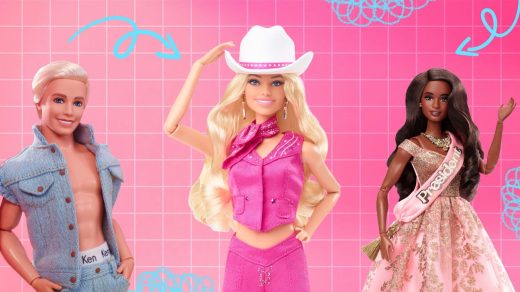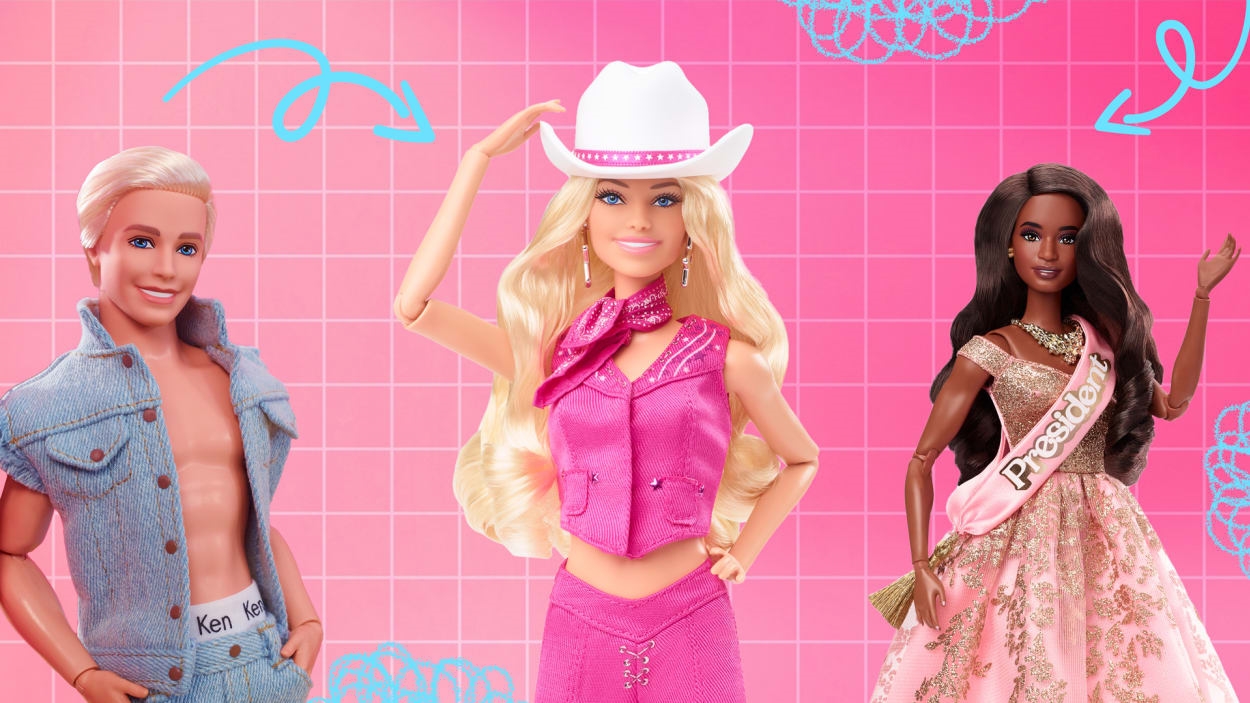Barbie’s global domination: Exactly how Mattel pulled it off
It’s an almost impossible task to objectively pick the single best piece of marketing for the Barbie movie.
The Xbox console made to look like a mini Dreamhouse is certainly a contender. As is the IRL Dreamhouse Airbnb listing. Of course, then you have the Aldo shoes, the Gap collection, the Barbie Dream Car in Forza Horizon 5, the Progressive Insurance tie-in ad, the Ruggable collection, Pinkberry frozen yogurt, the Hot Wheels car, and even star Margot Robbie’s Architectural Digest tour of the Dreamhouse. Those are just a handful of the promos and more than 100 brand tie-ins for the coproduction between Warner Bros. and Mattel Films, which premieres in theaters today. The pink-hued onslaught has turned us all into Barbie girls in a Bar-bie wooooorld.
A year in the making, the reportedly $100 million marketing-hype cycle has built up almost unprecedented awareness and interest in both the film and the brand. According to The Quorum, overall awareness of the film has reached 83% among women under 35 years old, the highest ever recorded by the firm, which projects the film’s opening weekend to hit up to $150 million.
This is what happens when a global heritage brand cultivates a unique pop-culture moment. Independent of the film itself, the campaign is the product of many expertly crafted elements all working together.
Mattel has been building toward this Barbie party for almost a decade, and the playbook the company has used for this brand is one it will adapt for other franchises that it hopes to expand beyond toys and games. Mattel president and chief operating officer Richard Dickson doesn’t see the Barbie movie as a finish line then, but rather pink, glittery starting blocks for what’s to come.
“What you’re really starting to see is Mattel as a pop-culture company,” says Dickson, who helped oversee the Barbie brand in the 2000s and returned to the company in 2014 in a C-suite role. Mattel currently has a whopping 45 film projects in development, including 13 that have been publicly announced, including He-Man, Rock ’Em Sock ’Em Robots, and Hot Wheels. “We represent pop culture, our brands are a canvas for common conversations around pop culture, we can express our brands’ identity across multiple categories and experiences that bring it to life in meaningful ways.”
But Mattel’s journey from iconic toymaker to pop-culture juggernaut was far from guaranteed.
Rock Bottom Barbie
In 2014, Mattel had a real Barbie problem. The brand was in the pit of a three-year sales decline; but worse, its image was in disarray. According to the company’s research, Barbie was outdated and didn’t reflect the diversity or image of modern girls. Just as importantly, they didn’t communicate the image that their parents wanted to see.
That’s when Mattel really dug into the data to find out what was missing. Barbie was the company’s crown jewel brand, and they needed to find a way to fix it.
“People weren’t seeing her in the same way that we did, as aspirational and inspirational,” says Dickson. “The feedback that we got was that she wasn’t a reflection of cultural relevance. She didn’t look like the world that we live in. We were missing the mark. We took those insights and really re-engineered everything.”
Barbie’s resurgence can be traced back to that moment.
It began with a new brand campaign, led by a spot called “Imagine The Possibilities.” Created with agency BBDO San Francisco, it’s a hidden camera-style ad featuring young girls taking on adult jobs, such as being a veterinarian, a college professor, professional soccer coach, museum tour guide, and corporate business traveler. The hook? The story flips, and the confused and amused adults are replaced by Barbies, showing these girls just playing these imaginary roles. The ad went viral almost immediately, reframing the narrative around Barbie, and unleashing a wave of nostalgic affection for the brand. The Washington Post declared it was “The Barbie commercial you have to see.”
Dickson today calls it “a reintroduction that we needed at that time, based on insights to reintroduce the value of Barbie play to parents.”
Soon after, Mattel launched Barbie dolls in different ethnicities, with 24 different skin tones. Its Fashionista line, released in early 2016 included three different body shapes—original, curvy, and petite—with more than 20 different available eye colors and hairstyles. Barbie sales rebounded, growing by almost 16% that year.
“We moved from what I call being a brand that had a monologue with consumers to a brand that needed to have a dialogue,” says Dickson.
As a kid, Jenna Isken played with Barbies. Now, as a group director of experience at branding agency Siegel+Gale, she has a new appreciation for how Mattel turned things around. “Barbie used to stand for a little plastic doll that nobody looked like, and now it stands for a universe of different people, looks, and occupations,” says Isken, who says she now buys Barbie stuff for her daughter. “It’s this really interesting study of how they took the nugget of who this brand is and found ways to forge new, better relationships with its audience.”
It’s a Barbie (branded) World
Since the Barbie movie is a coproduction between Mattel and Warner Bros, the toy company was deeply involved in all the film’s marketing and led all its brand partnerships. Dickson calls the gradual partnership announcements, which grew to be a flurry of them leading up to the film, as “candy in the road” for fans. “These partners that you’re seeing across the board, they’re not random. They’ve been a very calculated and precision-based marketing execution,” he says. “It really is a constellation of ensuring that every age—and every category—has best-in-class partners, where you can play Barbie.”
Brand strategy consultant Moshe Isaacian says it’s clear that these brand relationships were purposeful. “A lot of these partnerships have been in the works for more than a year, some two years; and to think of integrating something like video gaming into this brand, down food avenues, and other really interesting product areas, all coming out at a pretty fast pace, really got my attention,” says Isaacian.
Isken actually sees the brand-partnership aspect of the film’s marketing as the toughest needle to thread. ”Because you have to make sure that these brands come together, in order to be authentic to the people you’re trying to get excited, in a way that makes sense for the brand, is protective of the brand, but also strengthening those relationships,” says Isken. “So I look at the Gap, for example, who it is, what it represents, clothing for all, promoting individuality, and that makes a lot of sense.”
Barbie’s Malibu Dream Brand Playbook
“Imagine The Possibilities” and all the product development around that same time were a result of a new Barbie playbook that Dickson says consists of four main elements. It starts with brand purpose, which Dickson defines as, Why are we here? “This exercise was a really important one for Barbie and for every one of our brands to really establish,” he says. “What made us great to begin with? And how do we start to personify our purpose through meaningful touch points and execution?”
Next is what the brand calls “design-led innovation.” For Mattel, it means knowing their consumer better than anyone, and the creativity that comes from that—and then exceeding expectations through the product that they ultimately create.
The third element is cultural relevance. This plays a vital role in connecting brands and products with popular culture, and it drives demand. It can be everything from fun digital content to having the products reflect an ever-wider variety of play possibility. Barbie’s career sets, for example, have Barbie as a marine biologist, a chicken farmer, a teacher, a hockey player, and more. Oh, and Ken as a dog trainer. In April, the brand launched its first-ever Barbie with Down syndrome, after working with the National Down Syndrome Society.
Finally, there’s executional excellence. “This is really an obvious one,” says Dickson, “but you can have great ideas, but if you can’t execute, then it really doesn’t mean anything to anyone.”
As Mattel has seen the success of this strategy play out over the past seven years, leading to this one massive pop-cultural moment for Barbie, the company is hoping that it can adapt these principles to all of its properties. “We recognized as a portfolio that the playbook was pioneered by Barbie, but it’s now personified throughout our entire ecosystem,” Dickson adds. “I think it really represents the next chapter of growth for our portfolio.”
Beyond Barbie
As much as Dickson and Mattel want to build out the Mattel portfolio across film and TV, there’s a reason that Barbie is first in line. In addition to being the company’s most important and enduring product line, Barbie was also the most logical adaptation to narrative storytelling, both due to its cultural presence and character-based products. Rock ‘Em Sock ‘Em Robots may be fun, but they’re not Barbie.
Isken says that she can see the potential for something like Hot Wheels, but for any brand looking to adapt and expand on its intellectual property, it’s about understanding the size of and potential for that audience, and then being willing to invest in creating a fandom. “Make sure you’re taking the time to do so much listening, you’re looking for opportunities and areas for people in that audience to contribute,” says Isken. “Whatever you’re creating, you’re also finding the opportunities to pivot to show audiences that you’re not just listening but allowing it to have an impact on where you’re going.”
Isaacian adds that the brand partnership aspect of the Barbie movie will have a broader impact. “It’s going to be hard to replicate on this scale, but the ideas of where you can plug into, I think will inspire many other marketers to think more creatively about where they can go,” he says.
So far, the biggest lesson that Dickson and Mattel have learned from the Barbie movie experience is the importance of discomfort and taking calculated risks. ”To personify our brands in culture, particularly in content, we are working with the greatest creators and content in the world,” says Dickson. “Greta Gerwig is a genius. Margot Robbie is spectacular. [We need to] recognize that they do love the brand, that they’re authentic about the brand we need. And ultimately, let them play within that framework. In order for us to create breakthrough products, whether it’s film, TV, or merchandising, we’ve got to stretch our own limitations.”
If the Barbie movie earns anywhere near its projected opening box-office numbers, expect Mattel to sparkle like glitter across the culture for years to come.
(15)



